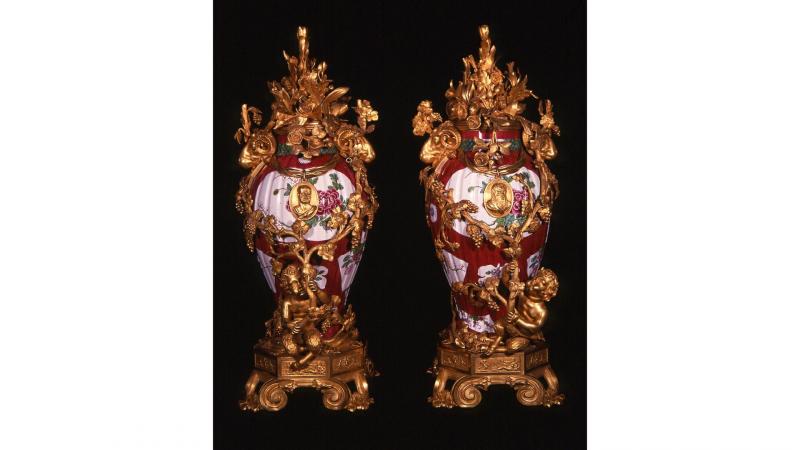These two vases are part of a prestigious set of ten pieces (six vases and four cornets). Four vases and two cornets were made from Tournai soft-paste porcelain; they were perfect imitations of two vases and two cornets made from hard Chinese porcelain during the Qianlong period (1736–1795). Today, this set is split between the Philippe de Rothschild collection in Paris, the James de Rothschild endowment in Waddesdon Manor and the Grand Curtius museum. These two may also come from the Austrian branch of this family.
The Tournai pieces were intended to be mounted and the elements of Chinese origin to be concealed. It should be noted, however, that Chinese vases were very likely to be covered at the beginning. The set has been enriched with gilded bronzes, which had the sole purpose of increasing the prestige.
A princely order.
There is no doubt that this prestigious collection was designed for the lounge of the Palais de Bruxelles by the Governor of the former Netherlands, Charles-Alexandre de Lorraine (1712–1780). They form part of the inventory at the time of his death and had an estimated value of 5,000 florins. The gilded bronzes were produced in 1776–1777.
The prince particularly appreciated the oriental porcelains, entrusting their setting to the best goldsmiths. The exceptional "gold service" and "silver service" preserved in Vienna, which were worked on by London, Brussels and Viennese silversmiths, bear witness to this.
He was also interested in the manufacture of Peterinck pottery and porcelain in Tournai, which received the Imperial title and was protected by his Government.
The goldsmith
Michel-Paul-Joseph Dewez (1742–1804) signed a cornet and one of our vases: M. P. I. DE WEZ ORF. INV ET FECIT. These are the only preserved pieces from this important goldsmith, who was the younger brother of the famous architect Laurent-Benoit Dewez. Born in Luxembourg to a family from Rechain (Verviers), he was the first companion of the ordinary goldsmith for the King of France, the Belgian Jacques Roëtiers, before he settled in Brussels, probably at the invitation of Charles of Lorraine. Despite his reputation and experience, he had to submit to the fuss of the goldsmith trade in Brussels, only becoming a master in 1773 after a new apprenticeship in the Roos workshop. A goldsmith of the Court of Brussels, the rest of his output, especially pieces for rich Brabant abbeys, is only known through archival documents and drawings by his architect brother.
